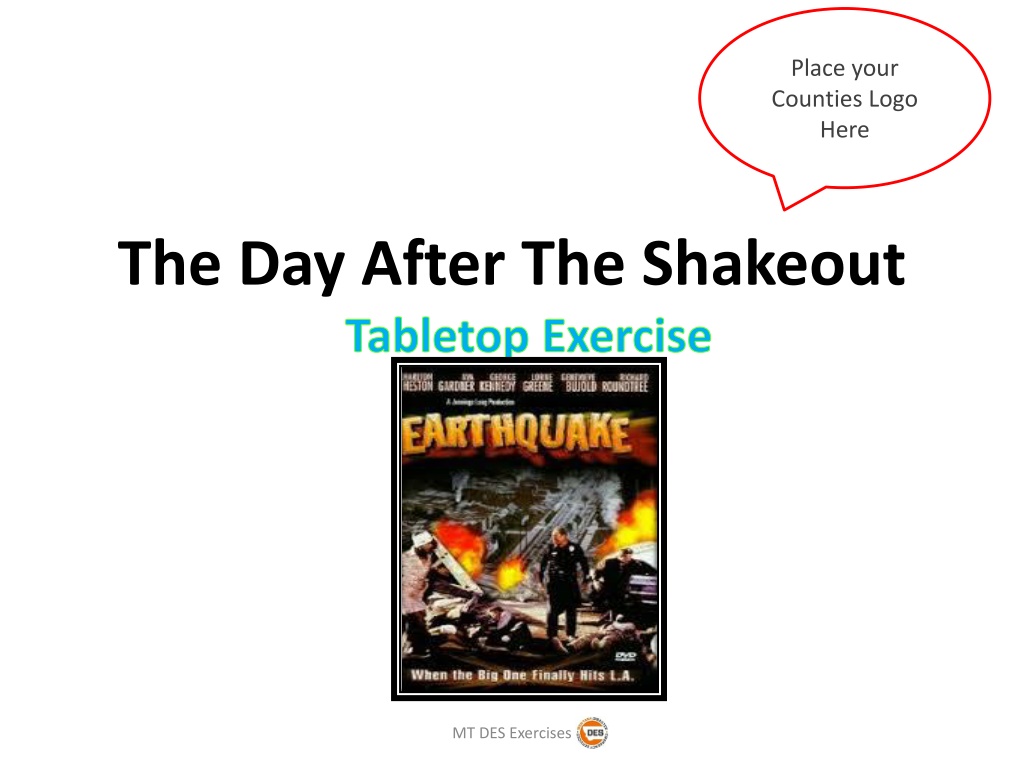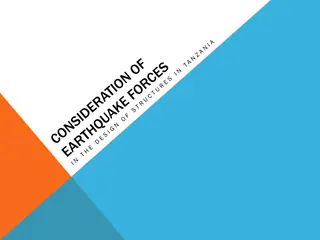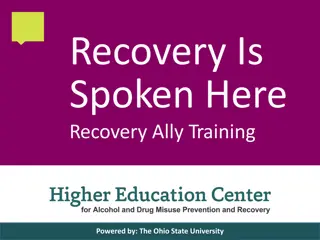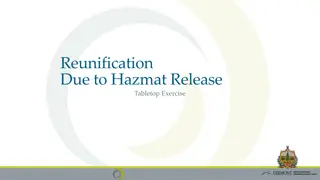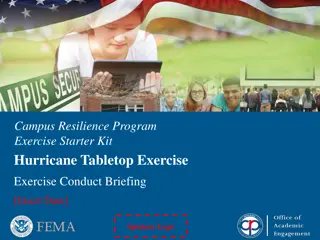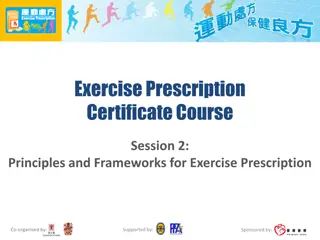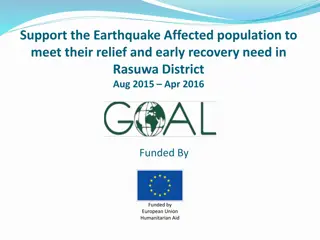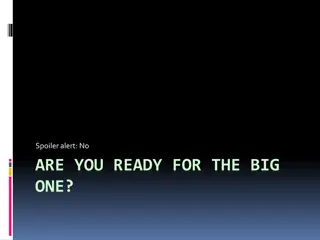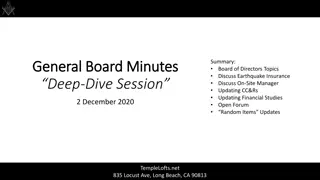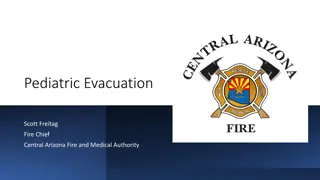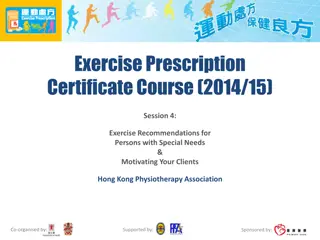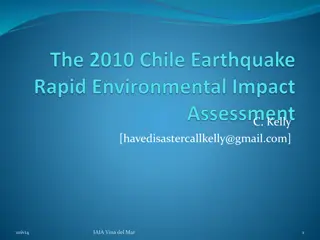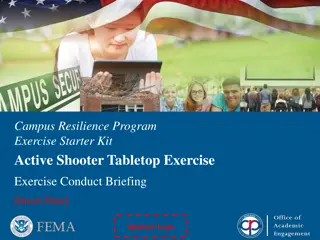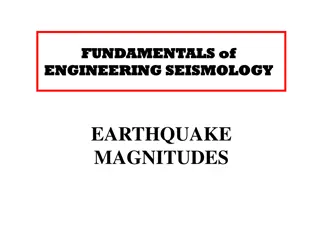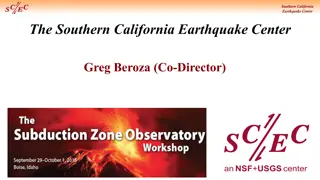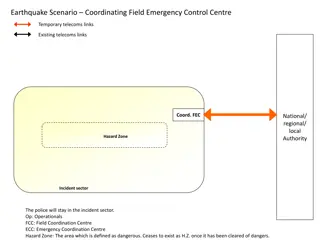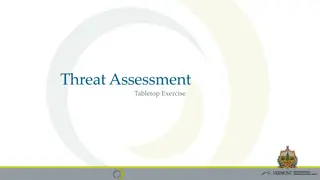Earthquake Response and Recovery Exercise Overview
This presentation outlines the objectives, goals, and purpose of a tabletop exercise focused on evaluating response and recovery efforts after an earthquake. It emphasizes educating decision-makers, defining roles, coordinating operations, sharing information, and enhancing community resilience to earthquakes. The exercise aims to enhance infrastructure resilience, create situational awareness, and facilitate recovery in the aftermath of seismic events.
- Earthquake Response
- Tabletop Exercise
- Community Resilience
- Infrastructure Resilience
- Emergency Preparedness
Download Presentation

Please find below an Image/Link to download the presentation.
The content on the website is provided AS IS for your information and personal use only. It may not be sold, licensed, or shared on other websites without obtaining consent from the author. Download presentation by click this link. If you encounter any issues during the download, it is possible that the publisher has removed the file from their server.
E N D
Presentation Transcript
Place your Counties Logo Here The Day After The Shakeout Tabletop Exercise MT DES Exercises
Room Breakout Law EMS/Medical Enforcement Media/Press Local Business Fire Public Elected Officials MT DES Exercises
Background Each time an earthquake occurs in Montana, the news media and public asks, Does Montana have earthquakes? Short answer: Yes! In comparison with California, Nevada, and Utah, major earthquakes here are infrequent. But each year, hundreds of earthquakes do occur in and around Montana. Taking steps now to prepare your family and home will help mitigate the effects of moderate to severe earth shaking. One important result of the Day after the ShakeOut is that the key to recovery in any community lies with infrastructure: the essential facilities like roads, hospitals and dams; and the lifelines that supply water, power, gas, and communication. The more damage there is to infrastructure, the slower the recovery. That is exactly what this short exercise is designed to address MT DES Exercises
Purpose To evaluate the response and recovery efforts the day after an earthquake impacts your jurisdiction. To formulate a plan that addresses the communities response through information sharing and gathering to further create a community level of situational awareness MT DES Exercises
Goals Educate the decision makers within the jurisdiction to the effect of an earthquake within the region and the response/recovery responsibilities associated with the incident Define the roles and responsibilities within the jurisdiction for earthquake response/recovery Provide all aspects of public information to the communities Provide and assess levels of damage for decision makers MT DES Exercises
Objectives/ Core Capabilities Planning, Operational Coordination, Intelligence and info sharing, community resilience, Long-Term vulnerability reduction, R&D Resilience assessment, Threats & Hazard ID, Economic Recovery, Education of Elected Officials Define roles and responsibilities of IC in community Planning, Operational Coordination, Intelligence and info sharing, Threats & Hazard ID, operation communications Clarify ICS structure Provide Public Information & warning Operation coordination, operation communications Intelligence and info sharing, community resilience, Create Community Awareness Understanding the management of incident resources Intelligence and info sharing, community resilience, Operation coordination, operation communications, Protect, prevention, operational coordination, health & social services, threat & hazard identification. Recovering, supply chain, Identify public health issues Economic Recovery MT DES Exercises
Situation 1. You just had an earthquake in your jurisdiction (5.2 magnitude) that has created some structural damage (roads and buildings) roughly 24 hours ago. There have been spot power outages, no causalities and those who have been injured have all been identified. Sewer and Water damages have not been assessed as of yet. Transportation lines must be assessed, back up generators and temporary cell sites along with assessment of damage on City and County buildings. Small spot fires have been occurring, and an overall status of the infrastructure is not know . Public buildings have been affected and are not cleared for returning to normal daily business. MT DES Exercises
Questions for Situation 1. Who s in Charge of the response & recovery ? Do we know how many people are displaced ? What is the initial damage assessment ? Location of shelters (identified) ? Secondary EOC identified ? Infrastructure assessment, who does it ? Schools & Daycare assessment, who does it ? Do we need to declare an emergency or a disaster ? MT DES Exercises
Situation 2. It has been determined that water is not potable. A plan has been developed for water distribution and monitoring. An announcement is being formulated for public release through electronic, social media and print media. An initial damage assessment has been completed. The county courthouse is not safe to return to, however, is expected to be cleared with 48 hours. Local schools and the hospital are being evaluated and an estimate on their availability for use will come today. MT DES Exercises
Questions for Situation 2. How long until the water is going to be usable? What key items need to be in the message to the public about the water ? Where will (county business) be conducted and supported out of over the next 2-3 days ? Who will pay for clean up and debris removal? Is this just city/county property or all common areas ? Is there a plan for clean up and is it included in the EOP, or should it be included ? MT DES Exercises
Situation 3. It is now 48 hours after the event (Earthquake) 90% of the power has been restored to the County, the Courthouse has been evaluated and restored to service. The schools, daycares and hospital have been evaluated and restored to service. State disaster declaration has been approved Debris removal plan has been implemented MT DES Exercises
Questions for Situation 3. Is there a need for long term study to determine the effect on local infrastructure ? Should we conduct an After Action Report for the incident ? Is there a need for CISM debriefing ? Was our media plan effective to communicate to the population what we needed to communicate ? MT DES Exercises
Conclusion Be patient with each other and yourself Try not to judge things or make important decisions when feeling low. Build routines Take stock of what you have learned and how you have changed Remember what was important before the disaster Talk things over with others who are interested Think how you would like life to be in the future Give attention to what has been neglected relationships, recreation, family, leisure and private time Look for opportunity to share your stories Think about positive ideas and plans. Try to focus on what you can influence and not let your peace of mind depend on what others do. MT DES Exercises
Hotwash What did we learn from the exercise? What did we do well? What can we do better? How will we address what we learned? (who is going to take action?) When will we revisit the identified issues again? ( Where ?) MT DES Exercises
Thank You for Participating Please remember to plan Please remember to plan early for the 2015 Great early for the 2015 Great Montana Shakeout Montana Shakeout MT DES Exercises
